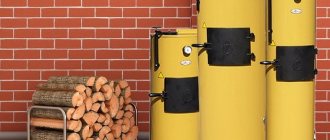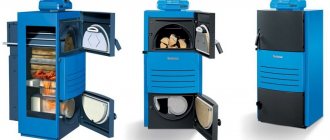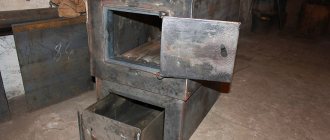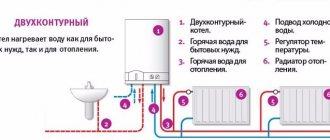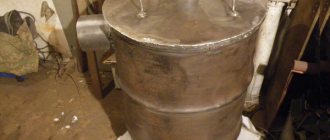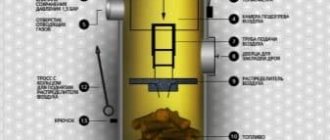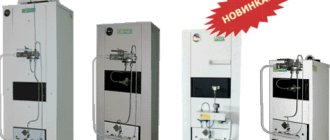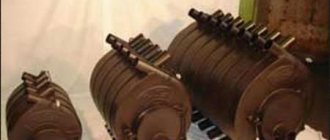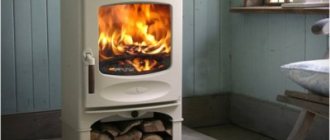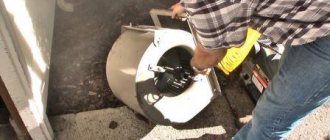Here you will learn:
- Operating principle of traditional boilers
- How do pyrolysis boilers work?
- A little chemistry and physics
- Ensuring long burning
- Advantages and disadvantages of pyrolysis boilers
Traditional solid fuel heating boilers are distinguished by their simplicity. There is practically nothing in their design except a firebox, doors, a thermometer and a heat exchanger. This simplicity leads to low efficiency and rapid combustion of wood. Therefore, in this review we will consider the operating principle of a pyrolysis boiler - it is more complex structurally, but it has a higher efficiency. This unit will also delight you with long-lasting combustion from just one load of firewood. Our review will tell you how this is implemented.
What is pyrolysis
Pyrolysis is a complex technological process. Its operating principle is the decomposition of organic substances under high temperature without air access. The described stage occurs in the lower chamber of the pyrolysis oven.
Thus, the structure of a pyrolysis furnace is quite simple. Its main component is a system of two chambers: a firebox and a gas combustion chamber.
In the firebox, after burning dry fuel, a small amount of solid residue remains, and gas burns out in the upper chamber. In addition, the design of the pyrolysis furnace involves a special valve in the chimney to regulate the flow of oxygen into the chamber, thereby reducing the intensity of the unit’s operation, or, conversely, increasing it.
DIY burner for a pyrolysis boiler
Today in Russia there are a huge number of settlements where there is no main gas pipeline, so it is necessary to heat the premises with electricity or accessible solid fuel. Of course, the latter option is much more economical, but it is also very labor-intensive.
You have to constantly monitor the amount of fuel in the boiler, make sure it doesn’t burn out, so you don’t have to re-heat it. The way out of this situation is pyrolysis boilers, which also operate on solid fuel, but the combustion process is optimized. The cost of such a boiler is higher than that of a conventional one, but it is quite possible to make it yourself.
We will tell you how to make a pyrolysis boiler with your own hands, drawings and principles of operation, we will provide recommendations from experts and video tutorials.
Photo 1 Operating principle of a pyrolysis boiler
Principle of operation
It is impossible to evaluate the advantages of pyrolysis boilers without understanding the general principles of operation. And initially, what is pyrolysis?
Essentially, this is the decomposition of natural compounds with a minimum amount of air. In a standard boiler, firewood burns at a temperature of 900-1200°C with normal air access; one load of firewood takes about 3-4 hours, releasing about 4900 calories of heat.
Table 1 Calorific value of firewood of different types of wood
In a pyrolysis boiler, solid fuel burns at a lower temperature - 300–850 ° C, and decomposes into the following elements - solid sediment and gas. In the absence of oxygen in a separate chamber, flammable (pyrolysis gas) reacts with carbon and is further processed, thereby increasing thermal conductivity.
Thus, during dry distillation (pyrolysis process), in addition to solid fuel, solid sediment is additionally burned and, at the same time, pyrolysis gas. All this together increases the burning time of one load of firewood to 12 hours (compare with the usual 3-4 hours) and the efficiency of the boiler to 85-90% with the standard 65-70%.
Pros and cons of equipment
Any unit has both positive and negative characteristics. In order to make the right choice, they must be adequately assessed.
Pros:
- maintaining a certain combustion temperature in automatic mode;
- increased burning time of the fill against the background of increased boiler efficiency;
- the ability to use various types of solid fuel, including processed products from the woodworking and agricultural industries.
It is not recommended to use more than a third of the total amount of fuel polymers and rubber.
Minuses:
- large dimensions of the boiler due to the enlarged combustion chamber;
- special requirements for solid fuel - firewood must be completely dry
When fuel is added to even 25% humidity, the process of gas evolution slows down, which leads to a decrease in coolant temperature and a drop in efficiency.
- energy dependence - during operation, the boiler consumes electricity to operate the fan, which creates forced draft, and automation;
- price is the main drawback that makes you refuse to buy.
That is why we propose to make a pyrolysis boiler with your own hands; see the drawings and principle of operation further in the article.
Boiler structure
The fundamental difference between a standard and a pyrolysis boiler is that in the first version there is 1 combustion chamber, and in the second - 2, between which there is a grate, the fuel itself and the solid residue are burned in the lower one, and pyrolysis gases in the upper one. It is this organization of combustion chambers that allows you to optimize the process, increase fuel combustion time and maximize efficiency.
Photo 2 Diagram of the pyrolysis boiler
The pyrolysis process is possible only with limited air access, when the fuel does not burn, but actually smolderes, releasing a larger amount of gas.
Among the features of a pyrolysis boiler is increased aerodynamic resistance in the chimney due to the absence of air and the reaction of carbon with pyrolysis gas. Forced draft is provided by an electric fan; in fact, it is for this reason that pyrolysis boilers belong to the category of volatile equipment.
Cost of a homemade model
Of course, the main reason why they start making a pyrolysis boiler with their own hands, looking for drawings and the principle of operation is banal savings.
On average across regions, the cost of a finished boiler varies from 36,000 rubles. (power 10 kW, area 100 sq.m.) up to 140,000 rub. (power 38 kW, area 300 sq.m.).
When making a boiler yourself, you can save from 500 to 1500 USD. due to the cost of materials and personal labor.
1 Pyrolysis boiler 15-25 kW - manufacturing and testing
In any case, this type of work cannot be called inexpensive or easy, so before you decide to make a pyrolysis boiler with your own hands, evaluate your capabilities, study all the drawings and select exactly the materials that are needed.
How to make a pyrolysis boiler
Tools:
- electric arc welding and 3-4 electrode packages;
- drill;
- small grinder (circle 230).
Photo 3 Metal welding process
| Name | Dimensions | Quantity |
| Pipe | Ø 57 mm, wall thickness 3.5 mm | 8 m |
| Ø 159 mm, wall thickness 4.5 mm | 1m | |
| Ø 32 mm, wall thickness 3.2 mm | 1m | |
| — | — | — |
| Profile pipe | 60×30 mm, wall thickness 2 mm | 1.5 m |
| 80×40 mm, wall thickness 2 mm | 1m | |
| 20x20, wall thickness 2 mm | ||
| — | — | — |
| Steel strip | 20x4 mm | 7.5 m |
| 30x4 mm | 1.5 m | |
| 80x5 mm | 1m | |
| — | — | — |
| Fireclay brick | 15 pcs | |
| Metal sheet | 4-5 mm | 7-10 sq.m. |
| — | — | — |
| Grinder circles | Ø 230 mm | 10 pieces |
| Ø 125 | 5 pieces | |
| — | — | — |
| temperature sensor | 1 PC | |
| Blower fan | 1 PC |
Photo 4 Blower fan
This list does not include an assortment of plumbing tools and some auxiliary parts. It is quite possible that some of them will have to be purchased in addition - but in general, even at this stage it is possible to calculate the cost of the boiler.
Drawing of a pyrolysis boiler (according to Belyaev’s scheme) 25-40 kW
Photo 5 Detailed drawing of a pyrolysis boiler
If possible, make a 3D diagram of the internal structure of the boiler to understand the basis of its structure and begin manufacturing.
Photo 6 3D diagram of the internal structure of the boiler with dimensions
DIY process
Cutting with a grinder will never give a perfectly even cut - only a guillotine can cut metal like that. You should not skimp on cutting metal, it can be expensive.
- When purchasing metal sheets and pipes at a metal warehouse, agree in advance to cut them into the necessary fragments. In the future, this will significantly reduce the time and make it possible to obtain even seams.
Photo 7 Metal cutting
- From two parts, begin to assemble the boiler chambers - combustion and gas
- When both chambers are made, you weld the air vents and the wall to their back. In the photo, for convenience, the channel is made of a channel, but it can also be made from a 60x30 corrugated pipe, for which you first cut small ventilation holes.
- In the combustion chamber, make a hole for the air pipe and weld a pipe to it. Please note that this pipe must be connected to the boiler using a 20x20 corrugated pipe.
- Manufacturing a tubular heat exchanger - cut several holes on the workpiece for a D57 mm pipe.
- The D57 mm pipe is cut into pieces of equal size, which are then placed on a plate and welded around the perimeter.
- Next, the heat exchanger is arc welded to the boiler and a throttle valve is made
- The front wall is welded onto the chambers, where 2 holes are pre-cut - for the inlet and outlet air pipes
- Next, the lid and bur are welded in place of the damper
- We have collected all the internal filling of the boiler, after which it is necessary to thoroughly clean the welding areas with a grinder or a wire brush.
- The outer casing on the boiler is made from 4 mm sheet and corners
- In order to fasten the outer casing to the corners, small holes should be made on the workpiece. Each of them should be welded so that the sheet and casing are properly connected
- Checking the tightness of the boiler using water - close the holes for the flow of coolant with plugs and fill it with water. If there is a leak in any place, make a note so that the area can be dealt with immediately. The boiler must be completely sealed
- The top cover needs additional insulation
- To regulate the operation of the air dampers, you will need threaded rods
- The boiler is completely covered with an outer casing, and an air outlet pipe is made from a professional pipe.
- The hinges are welded on and the door is put on. It is better to make it from cast iron plates, and use brick for lining (protection from damage).
- The lower chamber is also lined with refractory bricks - this should be cut and ground so that the chamber fits snugly
- In order for the boiler to meet the declared power, the damper in the lower chamber must meet certain parameters. When laying bricks, be sure to take it into account
- A blower fan is welded onto the air duct pipe (from a profile pipe) to create forced draft in the boiler
- The lower chamber is also sewn into brick to make it as safe as possible and optimize the combustion process.
- To improve the operation of the boiler, it is recommended to make turbo swirlers; on the one hand, they improve heat transfer, and on the other, they clean the pipes of deposits.
- Before starting the pyrolysis boiler, it is necessary to check how tight the seams are according to the same principle as in point 13 (see above). But at the same time with water, it is necessary to create a pressure of 3-4 bar. To do this, you can use a special pressure tester - when increasing the pressure, watch how quickly it drops. If it's leaking quickly, look for that place. If it stabilizes, everything is fine.
- Be sure to install a safety group on the boiler, which includes a pressure gauge, emergency pressure relief valve and air vent. When the pressure increases above 3 bar, an automatic reset will occur.
- In order to maximize the safety of the boiler and make its operation trouble-free, we recommend installing an automation unit. To see how it works and why such automatic control is needed, watch the video instructions
Furnace fuel
Since these stoves are universal in relation to the combustion products used, craftsmen use a variety of fuel options for their units. However, most modern boilers operate using solid fuel. Such heating devices operate on wood and pellets.
The following types of fuel are distinguished:
- Firewood. Firewood is prepared from various species and types of trees. For example, birch trees and conifers have the greatest heat transfer. Also, oak firewood is quite heat-intensive, but its wood is quite expensive, and most of these trees are listed in the Red Book due to uncontrolled logging. In addition to the trees listed above, firewood from alder, ash and hazel is often used.
- Pellets. They are compressed plant materials in the form of separate small cylinders. Straw, husks and branches are used as raw materials for the production of pellets.
- Coal. Such raw materials are used to maintain heat in industrial premises.
- Eurodrova. Their more common name is “fuel briquettes”. Unlike pellets, they are large in size, however, the raw materials for their production remain the same.
The essence of the pyrolysis process
In solid fuel pyrolysis boilers, types of organics are used that, upon thermal decomposition, give a high yield of volatile combustible substances. Such boilers operate not only on wood (and all types of wood fuel, such as pellets or fuel briquettes), but also on coal, up to coking grades, the combustion temperature of which reaches very high values!
smoldering fuel
The fuel in pyrolysis boilers is placed on the grate. After igniting the loaded batch of fuel, the tight door closes and the smoke exhauster starts working. As a result, the temperature in the combustion chamber rises high, up to 800 degrees, but there is no oxygen from the air for normal intense combustion. Instead, fossil fuels smolder and char, releasing volatile gases, primarily hydrocarbons.
Under the influence of convection, volatile flammable gases enter the space under the grate. The nitrogen present in the primary air in the furnace also migrates with them. Under the grate, oxygen from the secondary air supply circuit is mixed into the gas mixture. The resulting mixture already has the ability to burn. It burns, performing a useful function (for example, heating water in a heat exchanger), and in addition, the released heat goes back to the organic fuel and supports the smoldering process.
Advantages and disadvantages of units
Among the wide variety of heating units, there are two main groups based on the principle of heat transfer, these are:
- Furnaces with a water circuit. In such units, water is heated, which releases heat into the environment for a long time, thereby ensuring long-term maintenance of a high temperature in the room. Among the advantages of such heating systems are their profitability and relatively low costs. However, there is a high risk of the colorimeter freezing, and the cost of additional plumbing work with such a unit may unpleasantly surprise the owner.
- Furnaces with different options for placing heat exchangers. In this case, the firebox is located above or below the air chamber. In the first case, it is necessary to install special smoke exhausters and fans. They create forced draft. If the firebox is under the air chamber, then natural draft works here.
Classification by material
There are a large number of types of pyrolysis boilers.
Stone stoves today are in fairly low demand and are installed extremely rarely.
A metal pyrolysis combustion boiler is used much more often, because it is more efficient than its predecessor. This unit is also easy to assemble and, if desired, can be moved from one room to another.
Among metal pyrolysis boilers there are:
- Potbelly stove. Perhaps the pyrolysis stove is the most convenient and multifunctional heating system. It can be used for cooking, for baths and saunas, and is also often used for heating both residential and non-residential buildings.
- Buleryan stove. One of the most versatile and frequently installed types of pyrolysis boilers. Provides heating for both residential and non-residential premises.
- Bubafonya stove. The design of such a boiler is extremely simple and understandable to any non-professional welder. In most cases, it is used to warm up non-residential premises.
- Furnace using waste oil (waste oil). It is also not used for heating residential buildings, but is actively installed in non-residential premises. It is very easy to manufacture and is a fairly economical model.
In addition, it is possible to cook food on such stoves. Their main advantage is that the heat generated in them is softer, and such stoves retain heat longer.
The main disadvantages are the large dimensions of the oven and its immobility. They are more problematic to install and install. Brick pyrolysis furnaces, most often, look more aesthetically pleasing than metal ones.
Ensuring long burning
The operating principle of a long-burning pyrolysis boiler is as simple as a matchbox. The thing is that such boilers are initially equipped with impressive combustion chambers. A large amount of wood fuel is placed here. Therefore, the combustion here is very long - one bookmark in some units is enough for 10-12 hours. Having laid firewood in the morning, you can go about your business all day, rather than looking into the firebox every 5 minutes. The same thing happens in the evening - we load the firewood and go to bed.
Long-term combustion is ensured by the very principle of operation of pyrolysis boilers, or rather, by the pyrolysis reaction itself. Large fireboxes are also present in traditional heating units, but pyrolysis makes it possible to slow down the combustion process even more. And not just slow it down, but also provide additional heat intake. And in particularly powerful units, heat is also spent on an additional cooling circuit - the warm water coming from here can be used for any household needs.
Criterias of choice
When choosing a heating unit, it is necessary to take into account all the features of the stove.
Combustion products do not contain harmful substances and are environmentally friendly. Also, when operating a pyrolysis boiler, it is possible to use a wide range of fuels. There is no need to constantly monitor such a device, unlike conventional ovens. When choosing a pyrolysis oven, you should pay attention to a large number of factors.
- Purposes of use. For heating non-residential premises, it is better to use metal stoves, because... they are more compact and easier to install.
- Oven location. An important factor in choosing a stove is its location. In the garage, metal pyrolysis ovens are usually used, while at home you can often see stone structures.
- Room volume. To heat a small garage or house, in order to save space in the room, they often resort to using small structures. Often these are metal pyrolysis boilers. Since stone stoves often occupy a larger area than metal products.
- Fuel used. As mentioned earlier, most pyrolysis furnaces are capable of operating on various types of solid fuel. Therefore, this is rarely a limiting factor when choosing a pyrolysis boiler.
Why does a pyrolysis boiler have such high efficiency?
Unlike classic solid fuel boilers, the process of “reverse combustion” occurs here, that is, heat is released not by the combustion process of wood, but by the combustion of the gas released. Now let's take a closer look.
The pyrolysis process itself
is the decomposition of organic compounds at high temperatures (200...800°C) and a limited amount of oxygen.
This releases gas
and waste coke.
This principle of operation is also used by gas generator boilers, where wood serves as an organic substance. The gas produced in this way burns at temperatures up to 1200°C and releases significantly more thermal energy than the firewood itself from which it was obtained. This way you can get up to 50% more heat. The efficiency of such boilers reaches 85...89%.
The following can be used as fuel:
- firewood,
- various pellets,
- wood chips
- fuel briquettes,
- coke,
- coal.
At the same time, the content of carcinogenic substances in the exhaust gases emitted outside is minimal, which is important for people who care about the environment.
Tips for making your own brick stove
Although a metal pyrolysis combustion furnace is more efficient and popular, a brick one is also often installed.
Fireclay bricks are also needed to make all of its internal partitions. Often such heating installations are located in saunas and residential buildings. At first glance, brick pyrolysis stoves can look like a fireplace and create a fairly pleasant and cozy atmosphere in a house or bathhouse.
Rules of operation and maintenance
Long-burning stoves are easy to use because the fuel burns out almost completely. Soot remains in small quantities, so the boiler does not require constant cleaning. Regular repair of a pyrolysis boiler simply means timely elimination of various faults.
If the shape of the firebox door changes, it should be corrected or simply replaced. If the structure diverges along the weld seam, then it is necessary to stop operating the unit and urgently fix the problem. Using a faulty pyrolysis boiler can be dangerous for its owners.
Device and circuit
Pyrolysis boiler diagram
The two chambers of a solid fuel pyrolysis boiler can be located differently, depending on the type of air supply to both fireboxes:
- due to the presence of natural traction;
- with forced air supply using a fan.
Installations operating on the first principle consist of a lower primary combustion chamber and an upper secondary combustion chamber, with air flowing from bottom to top.
The second principle involves placing the primary chamber on top and the secondary chamber below it, with air being forced from top to bottom.
Review of long-burning boilers using pellets and wood:
Safety precautions
In order for the pyrolysis furnace to be safe to use, it is necessary to follow the diagram and calculations, as well as select high-quality material and proper equipment.
Follow these operating tips:
- Dry solid fuel. Fuel moisture content is no more than 10-15%, otherwise it threatens to quickly cause the unit to malfunction.
- The boiler chimney pipe is removable. This allows for easy removal of soot and condensation.
- Under no circumstances should there be flammable objects or structures near the stove.
When choosing how to heat and hot water a home, people pay particular attention to cost and practicality, as this will affect regular monthly expenses for many years. Of course, each solution has its pros and cons. The advantages of pyrolysis furnaces compared to traditional solid fuel boilers include a low negative impact on the environment, reduced fuel consumption and reduced maintenance costs.
Disadvantages of gas generator boilers
Like all heating systems, a long-burning pyrolysis boiler is not without its drawbacks. The main one is the equipment’s requirements for fuel moisture; it cannot exceed 25% . Otherwise, the efficiency of the boiler decreases sharply, and the fuel consumption to produce the same amount of heat increases. One solution is to dry the raw firewood in a warm room.
Power outages will also interfere with the operation of the unit. There is a caveat here: solid fuel units are most often purchased as an alternative heat source to existing gas equipment. Accordingly, if there is a power outage, a gas heating unit can be started instead of solid fuel. In areas where outages are quite common, many homeowners already have diesel power plants. The additional 100–500 W of energy that a long-burning pyrolysis-type boiler requires to operate will not become a heavy burden for them.
Another significant factor is the high cost of equipment. This is an inevitable payment for a more complex design, additional equipment and automation. All technical solutions are aimed at cost-effective operation, so after 1–2 years the product will definitely pay for itself.
History of technology
Heating organic materials in the absence of oxygen leads to chemical and physical changes in them. In the past, these phenomena were used to produce charcoal. The most primitive method looked like this: the wood was covered with a clay mound and heated in the relative absence of air. With the help of this technology, coal production reached its peak in the 11th-12th centuries.
The serious consequences of such forest processing are now being felt in some areas of Africa and Asia. Despite its apparent simplicity, this method is not environmentally friendly. As a result of wood pyrolysis, resins are released, which are volatile products with a high molecular weight. They condense easily at normal ambient temperatures. But despite this, the solid residue (coal) has traditionally been a valuable fuel for primitive agricultural communities, due to the following qualities:
- high carbon content compared to the original wood;
- low sulfur content.
Previously, steel production, including successful attempts to cast cannons from it, was based on the reduction of iron oxide with carbon in coal. A similar technology using charcoal, based on the processing of eucalyptus, is also practiced in modern Brazil as economically justified.
Pyrolysis has found wide industrial application in coking operations. Furnace designs and reaction conditions varied depending on demand and prices for the final products. In mid-19th century Europe, carbonization of coal was used to produce gas that was used to heat and light homes. At that time, only royal palaces could use such innovations. Household use of pyrolysis gases ceased with the development of transportation of natural hydrocarbons.
How to make a pyrolysis oven with your own hands:
During World War II, many cars and trucks were converted to wood gas generated in vehicle-mounted mobile units. Their productivity was low due to the low energy density of the gas, which, as a rule, contained large amounts of nitrogen and other non-flammable compounds.
The durability of engines using such fuel was short and was reduced primarily due to fly ash entering the cylinders along with wood gas. But despite these shortcomings, the use of such machines was justified by the shortage of fuel. After the end of the war, these installations were forgotten until the present day.
Now the problem of obtaining fuel from biomass instead of fossil fuels is again relevant.
Modern technologies make it possible to obtain, through pyrolysis, high-quality purified gas suitable for heating from wood and agricultural waste.
Operating principle of furnaces
Pyrolysis of organic raw materials is the heating of biomass to a high temperature without air access.
Detailed structure of a pyrolysis furnace
Under these conditions, the fuel is converted into a mixture of three types:
- coal (solid);
- organic gases (gaseous);
- oils (liquids).
Fuel requirements
Pyrolysis stoves for home use, using briquettes, can be fully automated and the comfort of their maintenance in this case is comparable to gas stoves. The fuel for them is waste compressed under high pressure without chemical binders. This technology makes it possible to produce relatively dry briquettes with a high calorific value. Their properties, however, may be different.
Pyrolysis furnaces and boilers operate on a wide variety of fuels
Most of them are not destroyed during combustion in the firebox, while others can only be used in a mixture with lump wood or brown coal. Small briquettes are fed using screw conveyors and are therefore used in automated systems; larger briquettes are only suitable for manually operated long-burning pyrolysis ovens. Wood pellets intended for automatic installations are obtained in the same way as conventional briquettes. Their only significant difference is size. White pellets made of soft wood without bark are considered the highest quality.
For wood-fired pyrolysis stoves, the size and type of feedstock can significantly influence performance—more wood surface area results in more gas being released per unit time. Hard rocks gasify more slowly.
Service Features
An important point is to always keep the fuel dry - the recommended humidity is 12-20%. This is necessary not only for combustion efficiency, but also affects the service life of the stove. Water vapor released during drying and some gases during condensation form tars and acids that corrode equipment. Due to the fact that the calorific value of wood decreases along with humidity, its consumption increases. Burning raw fuel can reduce the life of furnaces by half.
The pyrolysis furnace does not require constant filling with fuel
During pyrolysis combustion, less ash is produced than during conventional combustion. In practice, this means that gasification furnaces require less care to remove heavy ash residues. But fly ash can be deposited in significant quantities on the ceramic fittings of the combustion chamber, leaving less and less space for combustion. The latter can lead to overheating and equipment failure. Therefore, it is necessary to clean the fan blades and chimneys at least once a year.
Almost all types of pyrolysis furnaces require such maintenance.
In addition to high efficiency, saving time on preparing firewood and kindling, pyrolysis stoves, compared to conventional ones, have another serious advantage - the ability to continuously adjust power. This property, together with efficiency, environmental friendliness and automation of combustion processes, makes pyrolysis furnaces the best alternative to traditional heating methods for country houses.
How to make a pyrolysis miracle oven:
In this article we will try to tell you in as much detail as possible about whether a high-quality pyrolysis oven can be made with your own hands for domestic needs. This can be a mobile traveling model or a stationary installation.
Materials and tools
The set of tools and consumables depends on what type of boiler it was decided to make.
For example, in order to make an all-metal long-burning pyrolysis boiler with your own hands, you will need:
Welders
- welding machine;
- powerful “grinder” with cutting and grinding wheels;
- electric drill;
- electrodes;
- control automation;
- blower fan;
- sheet metal 3-4 mm thick;
- a set of thick-walled pipes with a diameter of 20, 32, 57 and 159 mm;
- steel strip 30X4 mm 80X5 mm;
- steel corrugated pipe 60Х30Х2 mm and 80Х40Х2 mm;
- asbestos cord;
- steel rod;
- stamping brick;
- boiler diagram.
For a brick pyrolysis machine you will need slightly different consumables:
Fireclay brick
- ceramic brick;
- fireclay brick;
- steel sheet with a thickness of 4 mm or more;
- cast iron grates;
- boost fan;
- control automation;
- firebox and vent doors;
- boiler diagram.
How to assemble a pyrolysis oven with your own hands:
Pyrolysis – technological process
But in order to make it more clear during the work what and why, it is necessary first of all to consider the question of how the pyrolysis furnace works . After all, you must admit that few people can boast of knowledge about the processes occurring in a pyrolysis furnace. Knowledge of the theory about the operating principle of this heating unit will be useful if you build a camp or stationary pyrolysis stove with your own hands.
It is worth immediately noting that when operating such a unit, the principle is used in which the fuel is prepared with a lack of oxygen . For many furnace specialists, this statement is absurd. After all, as you know, for the normal operation of a conventional boiler or furnace, in addition to the fuel itself, an influx of fresh air enriched with oxygen is necessary. These two components, fuel and air, ensure the proper operation of any furnace.
Pyrolysis gas - a new page for ordinary firewood
But let's take things in order. What happens to fuel when it is burned?
- , gas is released from the fuel . In conventional stoves it is removed through the chimney (see Choosing a chimney).
- The hotter the oxygen-limited fuel gets, the more gas is produced.
For example, this process in oil refining is called cracking . Cracking, or pyrolysis of oil, makes it possible to obtain fuel for cars and tractors.
But this process can also be used with wood. Moreover, if for petroleum products the processing temperature should be 800 - 900°C, then for wood 450 - 500°C will be sufficient. In this case, wood forms a number of substances, such as:
- resin
- acetic acid
- charcoal
- acetone
- methyl alcohol
Pyrolysis oven - main advantages
As you can see, all substances are flammable. It is this property of the gas released during the smoldering of wood that the pyrolysis furnace uses: the gas obtained from the fuel is burned, which is why the second name for such furnaces is gas generators .
What are the advantages of this type of oven? This is first of all:
- High efficiency, 80% or more
- More economical fuel consumption
- Possibility of adjusting efficiency
- Recycling of waste rubber, polymers, wood industry waste
- Almost complete absence of harmful substances in emissions
- Minimum soot production
In addition, other types of fuel can be used to operate pyrolysis boilers. For example, household waste. Currently produced briquettes from various household waste and wood residues are an excellent fuel for pyrolysis furnaces.
Flaws
The main disadvantage of such ovens is:
- High cost
- The need for a constant supply of electricity
- When using fuel with a high degree of humidity, pyrolysis is impossible
The operating principle of a long-burning pyrolysis solid fuel boiler
In this article we will look at what pyrolysis boilers are, their disadvantages and advantages.
Pyrolysis solid fuel boilers - diagram, principle of operation, advantages and disadvantages
Pyrolysis is the chemical process of decomposing wood into charcoal and gas, releasing large amounts of energy in the form of heat. This process is possible at high temperatures (200...800°C) and limited oxygen content.
Pyrolysis boilers are boilers that are designed for heating premises; the basic principle of their operation is based on the release of pyrolysis gas and its combustion, photo 1.
Photo 1. Pyrolysis boilers
Fuel for pyrolysis boilers can be (photo 2.):
- firewood (optimal size no more than 450 × 250 mm (length × thickness);
- briquettes;
- sawdust, chopped branches;
- pellets;
- coke;
- coal;
- peat.
Photo 2. Pyrolysis boilers use various solid fuels
The most efficient type of fuel is wood , which emits the maximum amount of pyrolysis gas. For efficient operation of pyrolysis boilers, firewood with a thickness of at least 70...100 mm should be used. Also, in combination with firewood, you can use sawdust and pellets (up to 25%). Pyrolysis boilers do not work only on sawdust or chopped branches and wood, or work with very low efficiency.
Operating principle of pyrolysis boilers
Equipment that produces gas due to the pyrolysis of wood is called a gas generator. Firewood is placed in a closed container called a reactor or fuel chamber, photo 3.
The firewood is set on fire using matches or other means (stage 1). First, the wood begins to burn as in a regular boiler, and then, when the temperature reaches 200...800°C, the air supply valve to the combustion chamber is closed and then the process of wood pyrolysis begins to occur. During the decomposition process, wood gas (pyrolysis gas) is released, which is removed using an outlet pipe (stage 2). The chemical process of pyrolysis occurs with the release of heat (exothermia).
In the tube, these gases are condensed and fed into the combustion chamber (afterburning), where they are mixed with secondary air and then burned (stage 3). The temperature in the boiler is regulated automatically using an automatic valve, which ensures the supply of the required amount of air and pyrolysis gas to the afterburner. In the afterburning chamber, the combustion temperature of pyrolysis gas can reach 110...1200°C.
Photo 3. Operating principle of pyrolysis boilers
When gas burns, heat is released, which passes through the heat exchanger, thereby heating the water in the system, and the combustion products exit through the chimney (step 4).
Manufacturers of pyrolysis boilers claim that the efficiency of such boilers reaches 85...89% . It should be noted here that such efficiency of using the boiler is achieved only due to the optimal quality of firewood - in this case, the firewood should be as dry as possible. Let us present data for clarity on how the humidity of firewood affects the amount of heat (energy) received:
- burning 1 kg of wood with a humidity of 20% - power 4 kW;
- burning 1 kg of wood with a humidity of 50% - power 2 kW.
High humidity of firewood leads to intense release of water vapor, which, when mixed with pyrolysis gas, reduces the concentration of fuel, and thereby reduces combustion power.
Another distinctive feature of such boilers is the interaction of pyrolysis gas and combustion products, i.e. with the carbon contained in their composition. This interaction significantly neutralizes the release of harmful substances.
The temperature of the water in the return pipe that enters the boiler must be at least 50...60°C. A decrease in the temperature of the water that enters the boiler leads to the formation of condensation on the boiler equipment and an intensive corrosion process, which reduces the service life of a boiler made of steel. The internal thickness of the steel walls of the boiler must be at least 4...5 mm.
Design of solid fuel pyrolysis boilers
Nowadays, a very large number of pyrolysis boilers of various designs are produced, but their operating principle is the same, and the main components and parts are contained in each type of such a boiler, photo 4.
Photo 4. Examples of the design of long-burning pyrolysis boilers
The solid fuel pyrolysis boiler consists of two main chambers:
- loading furnaces (gas generating chamber);
- combustion chambers (gas combustion chamber).
In the loading furnace, the process of pyrolysis of firewood occurs. In the combustion chamber, the combustion of gas occurs, which is released from the wood due to pyrolysis.
Depending on the location of the combustion chamber, boilers are distinguished with:
- lower firebox;
- top firebox.
The most common boilers are with an upper combustion chamber.
Let us briefly consider the main advantages and disadvantages of boilers with lower and upper fireboxes (combustion chamber):
Advantages and disadvantages of boilers with lower and upper fireboxes
Pyrolysis boilers, depending on the type of draft, are divided into:
- with natural traction;
- with forced draft.
Natural draft is provided by a long (high) chimney. A forced draft boiler is equipped with a fan or smoke exhauster that operates from a 220 V AC electrical network. A forced draft boiler is more efficient, but depends on the availability of electricity.
Now let's briefly look at the disadvantages and advantages of boilers with forced and natural draft:
Disadvantages and advantages of boilers with forced and natural draft
Expensive long-burning pyrolysis boilers are equipped with a programmer, with which the required heating mode is set. Automation of the combustion process consists of regulating the operation of the circulation pump and exhaust fan.
The boiler body is made of steel or cast iron. Cast iron boilers (for example, “DAMAT PYRO”) are more reliable and durable because they do not burn out and corrode so quickly.
Advantages and disadvantages of pyrolysis boilers
Advantages:
- obtaining additional heat due to the combustion of gas, which is released during the pyrolysis of wood. When burning wood, significantly less thermal energy is released than when burning pyrolysis gas. Gas combustion requires less air than when burning wood in a conventional boiler;
- When burned, no soot is formed or is formed in very small quantities. Pyrolysis boilers, due to the combustion of wood and other types of fuel, emit 3 times less harmful substances and components than traditional solid fuel boilers;
- the wood is burned completely, which means that a very small amount of ash is produced in the form of dust compared to conventional wood combustion;
- high efficiency value (up to 85...89%);
- long-term operation of the boiler (the time between loading is 8...12 hours or more) and depends on the ambient temperature, the size of the living space, the power and design of the boiler;
- Possibility of adjusting the boiler power within the range of 30...100%. The combustion process of pyrolysis gas is easier to control than the process of burning wood or other types of fuel in a conventional boiler;
- in some modifications of such boilers it is possible to burn rubber and polymer products with minimal emissions of harmful substances and compounds into the atmosphere.
Flaws:
- dependence on electricity. The fan consumes energy in the amount of 80...100 W. To ensure uninterrupted and reliable operation of a pyrolysis boiler with forced draft, a system equipped with a low-power generator is used;
- large dimensions of boilers;
- high requirement for wood moisture content;
- pyrolysis boilers are produced only as single-circuit boilers. To heat water, additionally separate equipment should be installed;
- high cost of the boiler (approximately 1.5...2 times higher than the cost of traditional boilers).
Pyrolysis boilers are represented on the market by the following manufacturers: domestic Motor Sich, Burzhuy-K, Sts and foreign VIESSMANN, DAKON, ATMOS, OPOP, OLYMP, etc.
Publication prepared by GIDproekt expert
Konev Alexander Anatolievich
Pyrolysis boiler - operating principle
How does this boiler work? The boiler consists of the following elements:
- Gasification chamber
- Afterburner
- Air supply system (primary, secondary)
- Water jacket
- Grate
The operating principle is as follows:
- Fuel is loaded into the gasification chamber and ignited.
- Gas begins to be produced from the fuel .
- Primary air is supplied to the chamber, and due to excess pressure, gas begins to flow into the lower afterburning chamber .
- is supplied to the afterburning chamber , and the resulting mixture burns at a high temperature.
- The water in the water jacket of the boiler is heated and supplied to the heating system, while at the same time return water .
- The coolant used also serves as a boiler cooler.
Operating principle of traditional boilers
The operation of a pyrolysis boiler is not particularly difficult. But in order to understand all the advantages of the pyrolysis scheme, we should talk a little about the traditional scheme. It provides for direct combustion of wood in the firebox of the heating unit. The generated heat is sent through a heat exchanger to the heating system. Another wild part of the heat flies into the chimney, going into the atmosphere.
The simplicity of the operating principle of a traditional boiler allows you not to bother with the complexity of its design. There are only two important components here - a firebox of various sizes, as well as a heat exchanger made of steel or cast iron. There are no automation systems here, and the temperature is adjusted by opening or closing the blower door. The desired operating mode is controlled using a thermometer. Unlike pyrolysis boilers, the combustion intensity is regulated within minimal limits.
Let's see what the disadvantages of direct combustion of wood fuel are:
- Combustion is too fast, almost uncontrollable - does not allow you to set the desired operating mode;
- You cannot connect tracking electronics - all operations to adjust the combustion intensity will have to be done independently, using a damper;
- Reduced efficiency - the operating principle of classical boilers, unlike pyrolysis boilers, implies the removal of a large amount of heat into the atmosphere. At the same time, there is a reduced calorific value of firewood during its natural combustion;
- It is necessary to constantly add new portions of firewood - especially if the unit is not equipped with a large combustion chamber.
But there are also undeniable advantages:
The variety of possible types of fuel for solid fuel pyrolysis boilers is amazing: firewood, briquettes, sawdust, chopped branches, pellets, coke, coal, peat.
- Energy independence - unlike pyrolysis boilers, the operating principle of traditional units does not provide for connection to the electrical network;
- The design is extremely simple - the only thing that can break here is the heat exchanger. But breakdowns can be avoided if you choose a boiler with a cast iron heat exchanger;
- Undemanding use of firewood - if a portion of wood is already burning in the firebox, you can even add half-damp logs into it. The type of wood does not matter much either;
- Affordable cost - pyrolysis boilers, the operating principle of which we will discuss in this review, are significantly more expensive.
Thus, even the most imperfect equipment can have certain shortcomings.
Traditional boilers, unlike most pyrolysis boilers, are optimal for heating country houses that are not connected to electrical networks.
Unregulated pyrolysis - no advantage
Therefore, to control it, it will be necessary to install an electronic filling that will regulate the combustion process. Otherwise, your pyrolysis boiler will turn into an ordinary potbelly stove. However, if you are building a camp stove, then this option is quite acceptable.
The high combustion temperature of the generated gases requires the use of special materials that protect the boiler from burning out.
The combustion temperature of gases in a pyrolysis boiler reaches 1100 °C.
How do top loading gas generating equipment work?
Firewood in a top-loading pyrolysis boiler burns like this:
- The loaded firebox is ignited , the flame on natural draft heats the firebox to a temperature in the primary chamber of 60 °C.
- The door is closed and the primary air supply is turned on. Within a few minutes, the temperature in the combustion zone reaches 600 °C - the optimal mode for the decomposition of gases. Firewood smolders when there is a lack of oxygen.
Photo 1. The firebox of a pyrolysis boiler is loaded with firewood; the flame heats it up to 60 °C with natural draft.
- Air, previously passed through the flame of the primary chamber, is supplied to the secondary chamber. Hot gases mix, resulting in a mixture with a stoichiometric number - the optimal ratio of air and combustible gas.
- Passing through the nozzle, the mixture ignites and burns, releasing a large amount of heat. Part of the heat is spent to maintain combustion in the primary chamber.
- The heat is captured by a system of heat exchangers, and the released carbon dioxide is removed through the chimney.
